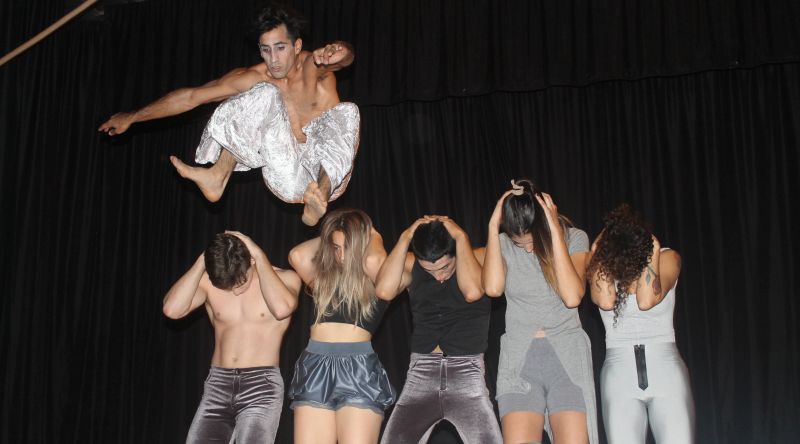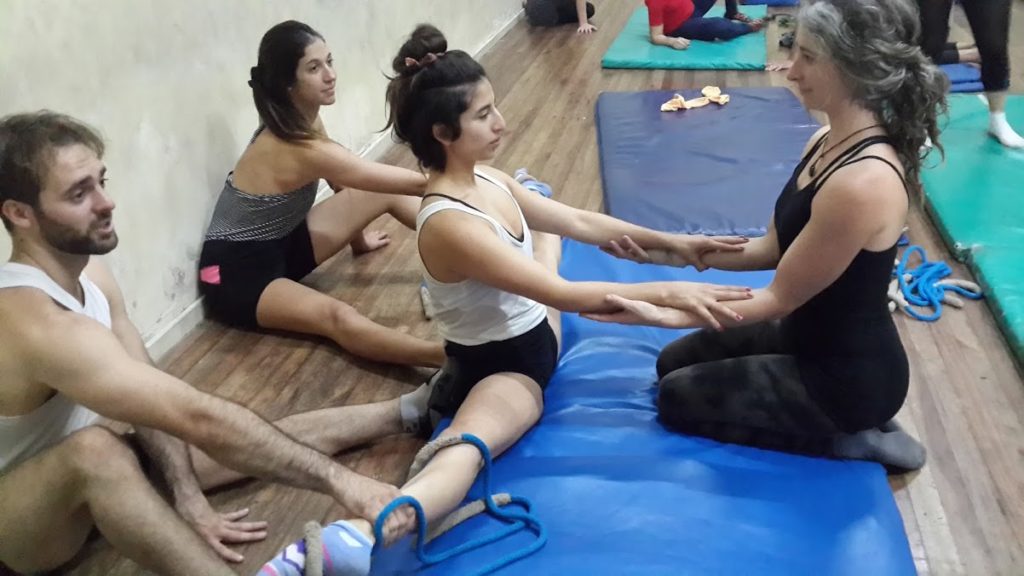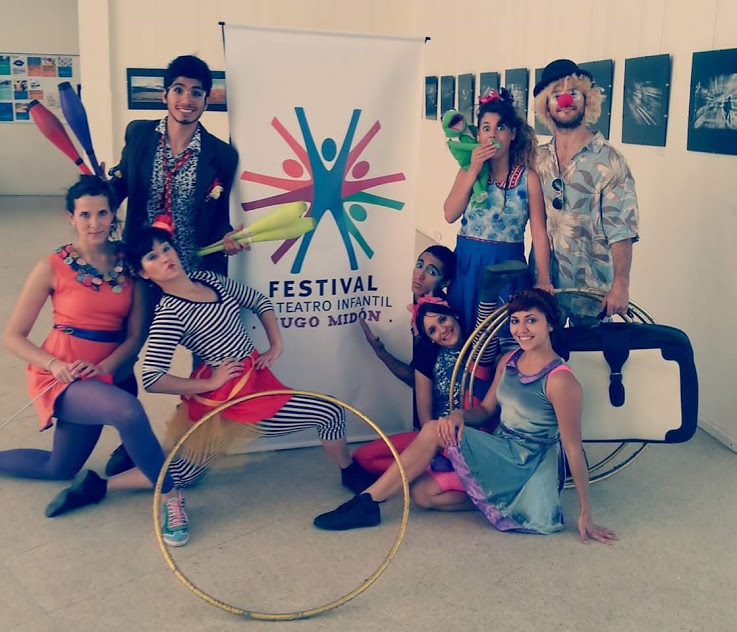Behind the Scenes at Circo De Las Artes-An Interview with Ana Hepner

Circo De Las Artes is a professional training school of Circus and Movement Arts, located in the Tigre province of Buenos Aires, Argentina. It was founded in 2009 by Ana Hepner, a dancer and acrobat. The school offers a 3-year professional course as well as recreational classes for adults and children. According to their website, the school is “dedicated to the research, training and integration of the Arts of Circus and Dance in the search for a multidisciplinary language”. A small and friendly space set in a lusciously green suburb right on the Tigre Delta, the school draws people from all over. The student body is mostly from Argentina, but I also met students from Chile, Ecuador, Australia and Italy.
 The school is small – maybe 20 students in the professional program altogether – and the space is divided into two rooms: a circus loft rigged with static trapezes and silks, and a dance studio with mirrors and ballet bars, dance harnesses hanging from the ceiling. Classes for the professional program include aerial arts (static trapeze, lyra, silks and rope), flow arts (juggling, hooping and fire spinning), dance classes (ballet, contemporary and jazz), ground acrobatics (tumbling, handbalancing and duo hand-to-hand), clowning and more. Recreational classes for adults are aerial disciplines only, but the kids get almost everything the adult professionals do. In the two months I’ve spent training here, I was impressed by the diversity of the classes and the school’s commitment to giving their students a well-rounded circus experience, one that will make them not only more employable but also more connected to their body as a tool for expression.
The school is small – maybe 20 students in the professional program altogether – and the space is divided into two rooms: a circus loft rigged with static trapezes and silks, and a dance studio with mirrors and ballet bars, dance harnesses hanging from the ceiling. Classes for the professional program include aerial arts (static trapeze, lyra, silks and rope), flow arts (juggling, hooping and fire spinning), dance classes (ballet, contemporary and jazz), ground acrobatics (tumbling, handbalancing and duo hand-to-hand), clowning and more. Recreational classes for adults are aerial disciplines only, but the kids get almost everything the adult professionals do. In the two months I’ve spent training here, I was impressed by the diversity of the classes and the school’s commitment to giving their students a well-rounded circus experience, one that will make them not only more employable but also more connected to their body as a tool for expression.
I sat down with the founder and director of the school to talk about her school, their relationship to FEDEC and the general atmosphere of circus in Argentina.
Stav Meishar: Please tell me a little bit about yourself and what led you to opening Circo de las Artes.
Ana Hepner: I was a dancer during all my life but I was curious about other types of movements. It was difficult to find different places with good teachers, and difficult to attend them all for a diversified formation. I went the the USA and got a scholarship to Steps Studio in NYC and had a great experience there. I learned floor barre, trained with Martha Graham and Alvin Ailee, and learned Horton technique.When I came back I was very disappointed with the small Argentinian dance world. I started gymnastics and learned a lot from sports people about progress and that it comes from training rather than natural talents, which is the belief in most dance studios. I somehow found myself in front of a trapeze and started training circus and I loved it. In between, I trained at Laban school in London and learned about dance therapy and healing through movement. So I got all these different methods and teachers and approaches and in Argentina all these different areas were disconnected, everybody working alone with the same goals but separated from each other. That’s how Circo de Las Artes was born. I wanted to work professionally–not just with talented and highly trained people–but with people who were mentally prepared to give the best of themselves, who are hardworking and willing to put in the time and effort. It’s the way you work that will make you professional in the end. So I opened a professional course in Argentina, combining dance, acrobatics, aerial arts, and infusing everything else I learned through the years.
SM:What do you find typifies circus in Argentina, how would you describe the community and the relationships?
 AH:I think Argentina has a very good in level of circus, we’ve traveled with our shows to other countries and in comparison I definitely found our students to be up there with the level of the bigger and more famous schools. But the way of learning in Argentina is different, there can be some disorganization and a chaotic approach. Sometimes, for example, performers are well-trained in aerial arts but they do not have any basis in ground movement. Schools here start with more of a chaotic passion, a desire to create a space to learn and teach and grow, not so much with the actual knowledge and skills required. Then they learn on the job, as they teach more and as the school evolves they hone their skills and they improve on their teaching abilities. The community is very friendly, we all know each other and are trying to improve the level of circus in general, with many people who want to teach better and learn more.
AH:I think Argentina has a very good in level of circus, we’ve traveled with our shows to other countries and in comparison I definitely found our students to be up there with the level of the bigger and more famous schools. But the way of learning in Argentina is different, there can be some disorganization and a chaotic approach. Sometimes, for example, performers are well-trained in aerial arts but they do not have any basis in ground movement. Schools here start with more of a chaotic passion, a desire to create a space to learn and teach and grow, not so much with the actual knowledge and skills required. Then they learn on the job, as they teach more and as the school evolves they hone their skills and they improve on their teaching abilities. The community is very friendly, we all know each other and are trying to improve the level of circus in general, with many people who want to teach better and learn more.
SM:How do you feel being part of FEDEC benefits your school, and how does it connect you to the international circus community?
 AH: Becoming part of FEDEC was a big step for us. In order to be accepted we had to answer a lot of questions, which made us organize what we do and think about where we’re going. I remember spending a whole summer answering questions and thinking about what we have done and what we should do. So, in a way, joining FEDEC made us mentally organize our work, to define and put words to what were simply actions done as they were needed. FEDEC is a very solid, well-organized federation. Here in Argentina federations are much more informal, but FEDEC is really solid and becoming part of a solid organization provided us a lot of support. They helped me a lot with topics of safety, student intake, acts, and training. Being part of this federation put me in contact with all these other schools and made me realize how we’re all connected, and how we can help each other and serve our mutual goals. FEDEC works with teachers and directors, hosting meetings for different disciplines, sharing knowledge and helping each other. I feel content to be a part of it, it can be very lonely to manage a school and as part of FEDEC I am part of an international community.
AH: Becoming part of FEDEC was a big step for us. In order to be accepted we had to answer a lot of questions, which made us organize what we do and think about where we’re going. I remember spending a whole summer answering questions and thinking about what we have done and what we should do. So, in a way, joining FEDEC made us mentally organize our work, to define and put words to what were simply actions done as they were needed. FEDEC is a very solid, well-organized federation. Here in Argentina federations are much more informal, but FEDEC is really solid and becoming part of a solid organization provided us a lot of support. They helped me a lot with topics of safety, student intake, acts, and training. Being part of this federation put me in contact with all these other schools and made me realize how we’re all connected, and how we can help each other and serve our mutual goals. FEDEC works with teachers and directors, hosting meetings for different disciplines, sharing knowledge and helping each other. I feel content to be a part of it, it can be very lonely to manage a school and as part of FEDEC I am part of an international community.
SM: You just came back from Europe, where you brought your graduating class to perform a show in a festival in Auch, France. What was that like?
AH: Many schools submitted to the festival, there was a lot of competition but only 8 schools were selected to present, so we felt very honored to be invited to participate. Seeing the shows of the other schools, and having them watch our show, really helped me realize that the level of circus in Argentina is impressive and measures up to the rest of the world. Also being there with other school directors, meeting and talking with them, made me realize we all share the same problems and concerns, even the biggest schools. We all deal with similar ongoing issues of funding and safety, we’re all trying to reach a higher level, all trying to make circus part of our country’s culture. Performing in Auch really helped us connect to the wider circus community.
SM:How do you think circus in Argentina will evolve over the next 5-10 years?
AH:I honestly think we are at the peak of our circus development, the level in Argentina is higher than it ever was before. But I also think that culture needs government support in order to keep surviving and growing. Our future will depend on the political climate and how our government will support the culture. The local circus community is trying to get the support, but even more institutionalized art forms like theater and dance are struggling, even the biggest dance companies are struggling to get support. Very few companies get support, and what they get is hardly enough. Circus is far behind and much less recognized. We are trying to change that, but it is a difficult struggle that often feels like a lost battle to begin with.
SM: Argentina has been in a financial crisis for years, and only recently has started to recover. Circus being art, and viewed by some as luxury, how does circus fit in the current social and economic landscape of Argentina?
 AH: Argentina is a crazy country, we never went out of the crisis. We are always in crisis, at any given moment. Things change constantly, the laws and rules are always changing, governments go from extreme right to extreme left in a flash… It can be very unstable and confusing. But Argentina is different from other countries in its approach to culture: our population always has a hunger for culture, is always looking up to Europe, always aspiring to have art in their lives. Argentina understands the value of art. Even in our worst moments, art and culture exist. Hundreds of groups of theater and dance have always existed here in the capital of Buenos Aires, no matter the political climate.
AH: Argentina is a crazy country, we never went out of the crisis. We are always in crisis, at any given moment. Things change constantly, the laws and rules are always changing, governments go from extreme right to extreme left in a flash… It can be very unstable and confusing. But Argentina is different from other countries in its approach to culture: our population always has a hunger for culture, is always looking up to Europe, always aspiring to have art in their lives. Argentina understands the value of art. Even in our worst moments, art and culture exist. Hundreds of groups of theater and dance have always existed here in the capital of Buenos Aires, no matter the political climate.
All photos courtesy of Agustina Ignacio
Editor's Note: At StageLync, an international platform for the performing arts, we celebrate the diversity of our writers' backgrounds. We recognize and support their choice to use either American or British English in their articles, respecting their individual preferences and origins. This policy allows us to embrace a wide range of linguistic expressions, enriching our content and reflecting the global nature of our community.
🎧 Join us on the StageLync Podcast for inspiring stories from the world of performing arts! Tune in to hear from the creative minds who bring magic to life, both onstage and behind the scenes. 🎙️ 👉 Listen now!
